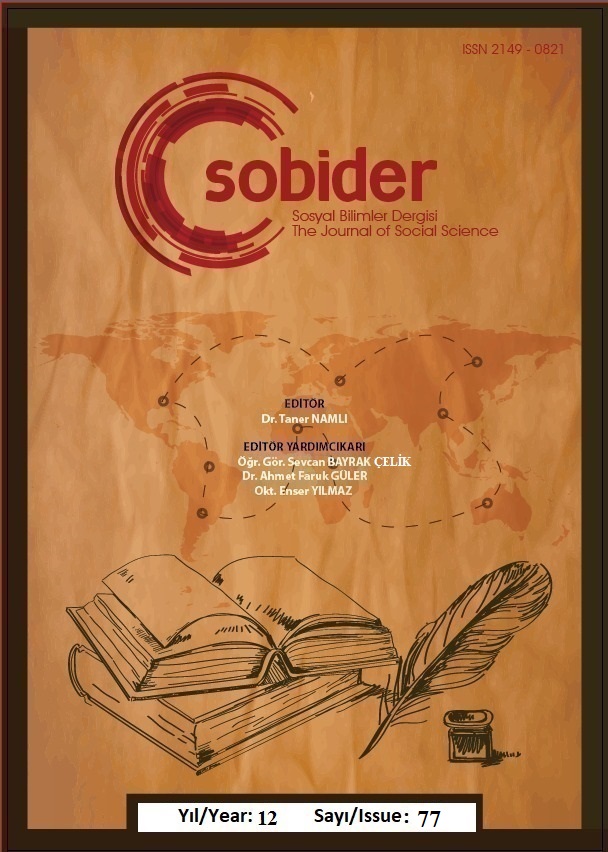Author :
Abstract
Bu makale, XVII. yüzyıl divan şairlerinden ve Sebk-i Hindî üslubunun önde gelen temsilcilerinden Nâilî’nin (ö. 1077/1666) gazellerinde yer alan klasik aşk mesnevelerine yapılan telmihleri, bu telmihlerin şiirsel işlevini ve anlam derinliğini ele almaktadır. Nâilî, Sebk-i Hindî’nin hayal gücüne dayalı yoğun, soyut ve çok katmanlı anlatımını telmih sanatıyla ustalıkla harmanlayarak özgün bir poetika oluşturmuş; böylece az sözle derin anlamlar ve ince hayaller kurabilen bir üslup geliştirmiştir. Çalışmada, Ferhat ile Şirin, Leylâ ile Mecnûn ve Mahmud ile Ayaz gibi klasik aşk anlatılarına ait tîşe, bîsütûn, cünûn, zülf, âh ve mahmil gibi sembolik motiflerin, yalnızca geleneksel edebî referanslar olarak değil, aynı zamanda beşerî ve ilahî aşkın, içsel çatışmanın ve hakikat arayışının imgeleri olarak yeniden anlamlandırıldığı ortaya konulmaktadır. Bu bağlamda telmih unsurları, Nâilî’nin beyitlerinde hem estetik yoğunluk hem de kültürel derinlik sağlayan temel öğelerden biri hâline gelmektedir. Makale iki ana bölümden oluşmakta; ilk bölümde klasik Türk şiirinde telmih sanatının işlevi ile Nâilî’nin poetik anlayışı incelenmekte, ikinci bölümde ise aşk mesnevelerine yapılan göndermelerin beyitlerdeki anlam örgüsüne ve çağrışım zenginliğine katkıları somut örneklerle analiz edilmektedir. Böylece, Nâilî’nin telmih aracılığıyla hem geleneği sürdürüp hem de kendi üslup özelliklerini öne çıkararak divan şiirinde özgün ve çok katmanlı bir anlam evreni kurduğu ortaya konulmaktadır.
Keywords
Abstract
This article examines the allusions to classical romantic mesnevîs found in the ghazals of Nâilî (d. 1077/1666), one of the seventeenth-century divan poets and a leading representative of the Sebk-i Hindî style, as well as the poetic function and depth of meaning these allusions provide. By masterfully blending the art of allusion with the intense, abstract, and multilayered expression of Sebk-i Hindî, which relies heavily on imagination, Nâilî created a distinctive poetics; thus, he developed a style capable of producing profound meanings and subtle images with minimal words. The study reveals that symbolic motifs such as tîşe (chisel), bîsütûn (Behistun), cünûn (madness), zülf (tress), âh (sigh), and mahmil (litter/palanquin), which belong to classical love narratives like Farhād and Shīrīn, Laylā and Majnūn, and Mahmūd and Ayāz, are reinterpreted not only as traditional literary references but also as images of human and divine love, inner conflict, and the quest for truth. In this context, allusive elements become one of the essential components in Nâilî’s couplets, providing both aesthetic density and cultural depth. The article consists of two main parts: the first examines the function of allusion in classical Turkish poetry along with Nâilî’s poetic vision, while the second analyzes, through concrete examples, the contribution of references to love mesnevîs to the structure of meaning and richness of associations in the couplets. Thus, it is demonstrated that through the use of allusion, Nâilî both sustained the tradition and highlighted his own stylistic features, thereby constructing a unique and multilayered universe of meaning within divan poetry.





